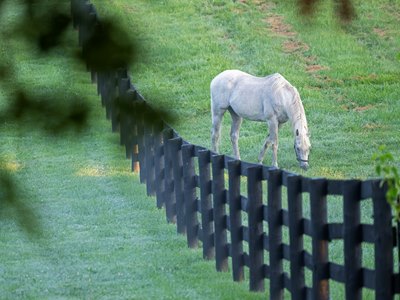Shades of Gray: Study Looks at Coat Color, Aging Horses


While horsemen are plenty familiar with gray horses turning white to the eye as they age, scientists recently discovered a genetic explanation behind this color transformation.
The research, completed by scientists from the Texas A&M College of Veterinary Medicine and Biomedical Sciences and Uppsala University in Sweden and published in the journal Nature Communications, determined that the number of copies of a small DNA sequence within the gray coat gene carried by each horse determines if they are "slow graying" or "fast graying." Those horses in the fast-graying category—the ones that eventually turn white to the eye—have a gene variant with three copies while the slow-graying horses—which remain a dappled gray color—have two copies.
According to the paper, gray horses that will eventually become white show telltale signs in the first week after birth. Observable traits include gray hairs on the eyelids, gray eyelashes, and gray hairs on the root of the tail. Beyond curiosity, the distinction is important because fast-graying horses are more likely to develop melanomas than their slow-graying counterparts.

"I got the idea that maybe slow-graying horses only have two copies of this (DNA) segment, and that turned out to be absolutely correct," said Dr. Leif Andersson, a professor in the VMBS' Department of Veterinary Integrative Biosciences at Uppsala University.
Through their research, Andersson and his team uncovered that horses in the "fast-graying" category will turn white in as fast as 10 years due to receiving chromosomes with three copies from both the sire and dam. Examples of famous racehorses or stallions with the "fast-graying" gene are Tapit and Winning Colors.

Michael Blowen, founder of Old Friends in Georgetown, Ky., recalled the changing look of Old Friends resident Silver Charm, who arrived at the farm at the age of 20 in late 2014.
"Silver Charm had lost most of his gray by the time he got here (and retired from stallion duties), but he was still speckled," said Blowen. "At 30 years old, he's all white. Not many gray hairs left."
"Slow-graying" horses, possessing two copies of the gene sequence from their sire and dam, will never become completely white and instead show a dappled gray coat with age. The signs of graying in a "slow-graying" horse may not appear until a horse has reached 5 to 7 years of age. According to the study, when a "slow-graying horse has reached an age of about 15 years, the coat color may turn into a dappled steel or bluish gray shade."
"I was amazed by the very strong correlation between copy number and both speed of graying and risk to develop melanomas," Andersson said.
Blowen said that several of his farm's gray residents have developed melanoma over the years, including 1991 Horse of the Year Black Tie Affair and 1996 Breeders' Cup Classic (G1) winner Alphabet Soup.
"Black Tie Affair had very bad melanoma when he died," Blowen said. "Both he and Alphabet Soup had terrible melanoma in their old age."
Alphabet Soup, however, was treated with a cutting-edge cancer vaccine in 2016-2017 that reduced the size of tumors by 75%-80%. The extensive treatment was provided through Veterinary Oncology Services-Morphogenesis and administered by Dr. Bryan Waldridge.

In a BloodHorse article at the time of Alphabet Soup's treatment, the IFX-vet multi-indication cancer vaccine "allowed the retired stallion's immune system to target and eliminate cancer cells by placing an indicator on the cancer cells to alert the immune system of the enemy."
ANGST: Alphabet Soup Progressing Under Cancer Treatment
Blowen believes the treatment allowed Alphabet Soup to live three or four years longer than Black Tie Affair, who died before the cancer vaccine was available.
Other than "fast-graying" horses' increased susceptibility to developing melanoma, the study noted that there were no other negative effects on a horse's health or performance due to carrying that particular genetic sequence.
